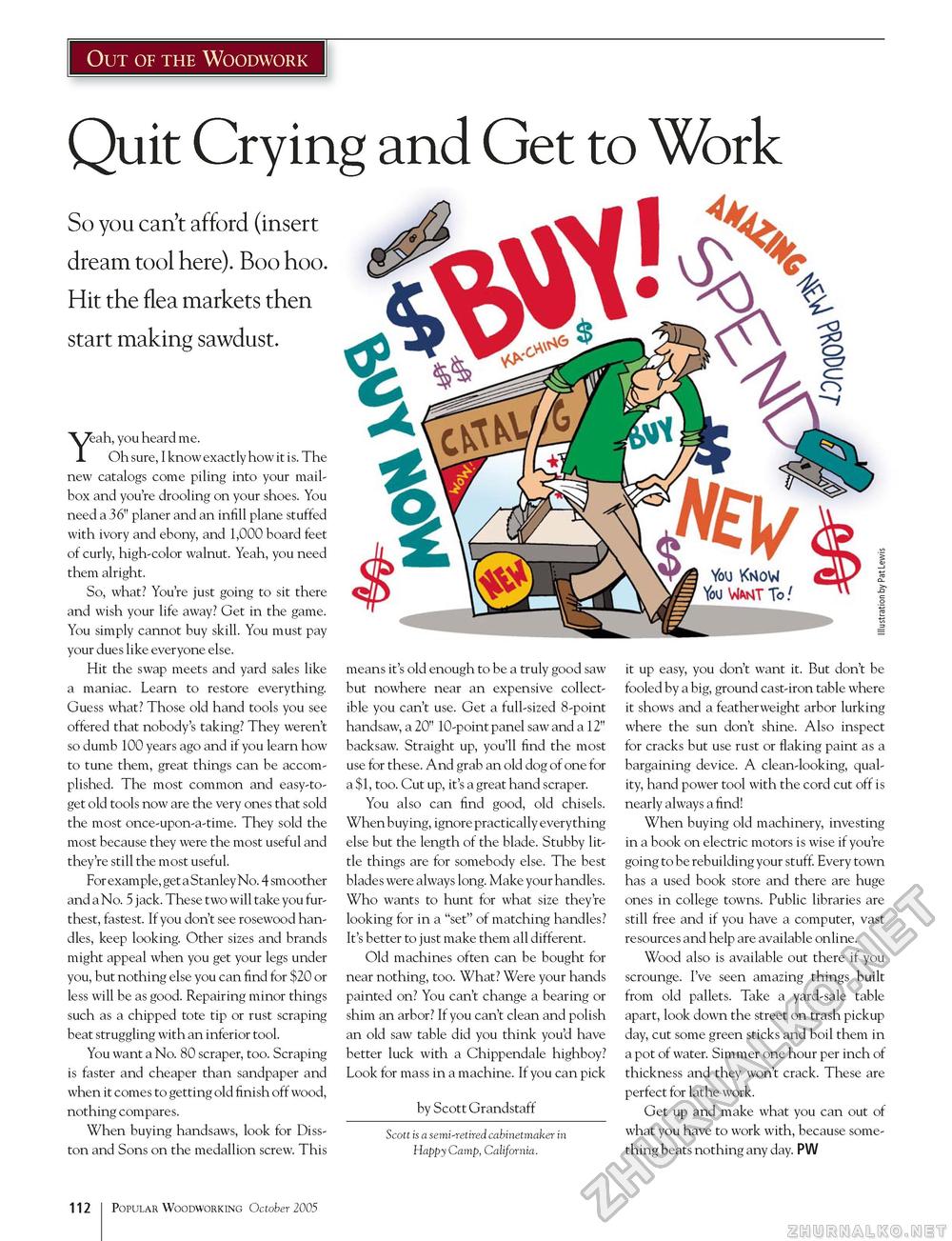Popular Woodworking 2005-10 № 150, страница 116
Out of the Woodwork Quit Crying and Get to Work So you can't afford (insert dream tool here). Boo hoo. Hit the flea markets then start making sawdust. Yeah, you heard me. Oh sure, I know exactly how it is. The new catalogs come piling into your mailbox and you're drooling on your shoes. You need a 36" planer and an infill plane stuffed with ivory and ebony, and 1,000 board feet of curly, high-color walnut. Yeah, you need them alright. So, what? You're just going to sit there and wish your life away? Get in the game. You simply cannot buy skill. You must pay your dues like everyone else. Hit the swap meets and yard sales like a maniac. Learn to restore everything. Guess what? Those old hand tools you see offered that nobody's taking? They weren't so dumb 100 years ago and if you learn how to tune them, great things can be accomplished. The most common and easy-to-get old tools now are the very ones that sold the most once-upon-a-time. They sold the most because they were the most useful and they're still the most useful. For example, get a Stanley No. 4 smoother and a No. 5 jack. These two will take you furthest, fastest. If you don't see rosewood handles, keep looking. Other sizes and brands might appeal when you get your legs under you, but nothing else you can find for $20 or less will be as good. Repairing minor things such as a chipped tote tip or rust scraping beat struggling with an inferior tool. You want a No. 80 scraper, too. Scraping is faster and cheaper than sandpaper and when it comes to getting old finish off wood, nothing compares. When buying handsaws, look for Diss-ton and Sons on the medallion screw. This means it's old enough to be a truly good saw but nowhere near an expensive collectible you can't use. Get a full-sized 8-point handsaw, a 20" 10-point panel saw and a 12" backsaw. Straight up, you'll find the most use for these. And grab an old dog of one for a $1, too. Cut up, it's a great hand scraper. You also can find good, old chisels. When buying, ignore practically everything else but the length of the blade. Stubby little things are for somebody else. The best blades were always long. Make your handles. Who wants to hunt for what size they're looking for in a "set" of matching handles? It's better to just make them all different. Old machines often can be bought for near nothing, too. What? Were your hands painted on? You can't change a bearing or shim an arbor? If you can't clean and polish an old saw table did you think you'd have better luck with a Chippendale highboy? Look for mass in a machine. If you can pick by Scott Grandstaff Scott is a semi-retired cabinetmaker in Happy Camp, California. it up easy, you don't want it. But don't be fooled by a big, ground cast-iron table where it shows and a featherweight arbor lurking where the sun don't shine. Also inspect for cracks but use rust or flaking paint as a bargaining device. A clean-looking, quality, hand power tool with the cord cut off is nearly always a find! When buying old machinery, investing in a book on electric motors is wise if you're going to be rebuilding your stuff. Every town has a used book store and there are huge ones in college towns. Public libraries are still free and if you have a computer, vast resources and help are available online. Wood also is available out there if you scrounge. I've seen amazing things built from old pallets. Take a yard-sale table apart, look down the street on trash pickup day, cut some green sticks and boil them in a pot of water. Simmer one hour per inch of thickness and they won't crack. These are perfect for lathe work. Get up and make what you can out of what you have to work with, because something beats nothing any day. PW 112 Popular Woodworking October 2005 |







